Building a brand and stand-up comedy are very similar fields. Why, you think?
Both require you to improvise depending on your audience’s reactions.
The Indian market has seen many brands appear and disappear within a few years. Each of these entered the race strong headfirst and eventually dissolved into thin air – hilariously similar to a joke that fails to land at a stand-up gig. The setup is strong, leaving the audience with bated breath for the punchline, but turns out to be something that makes you sigh at best.
We’ve all heard of the (in)famous saying: out of sight, out of mind. In the Advertising industry as well, this saying holds for every brand. Generating buzz around a product is pointless if the brand fails to look both inwards and outwards, and becomes unfeasible or inaccessible to users post-launch. For this, they must perform consistently by evolving along with consumer preferences.
In this article, we cover brands that became too proud of their previous monumental achievements and lost the empire they built to oversight. While they started strong, they missed out on continuous evolution and failed to timely decode their customer psychology. This, paired with continuous competition, resulted in the disappearance of these brands from the market. In our analysis, we offer an additional ‘lifeline’ for these brands, and how they could’ve kept their legacy alive.
eBay
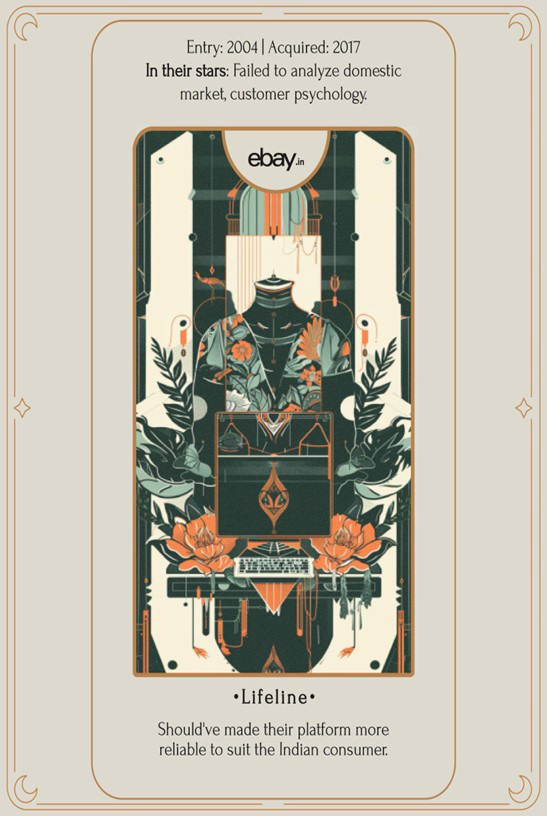
eBay’s revenue model – based on auctions – was a grand success overseas. However, they missed the trick when they moved to India when they failed to localize it to the domestic market. They faced poor reputation among buyers & sellers – customers were largely unhappy with the growing number of fake listings and poor customer support.
The brand failed to effectively tap into the psychology of the Indian consumer, and could not establish online buying and selling as an authentic channel of making money. They reportedly also hired industry veterans in senior positions to enhance their policies, but these attempts went in vain.
During eBay’s decline, other online marketplaces like Flipkart and Amazon were building base in India. Flipkart, which had become a household, trusted name for online purchases, ended up acquiring eBay India in FY 2017-18.
eBay India’s Lifeline:
The brand should’ve focused on using marketing strategies to establish the marketplace as a legitimate platform, and to build their consumers’ faith in their offerings. The brand image needed to be more user-friendly and inclusive to appeal to people.
Khadim’s
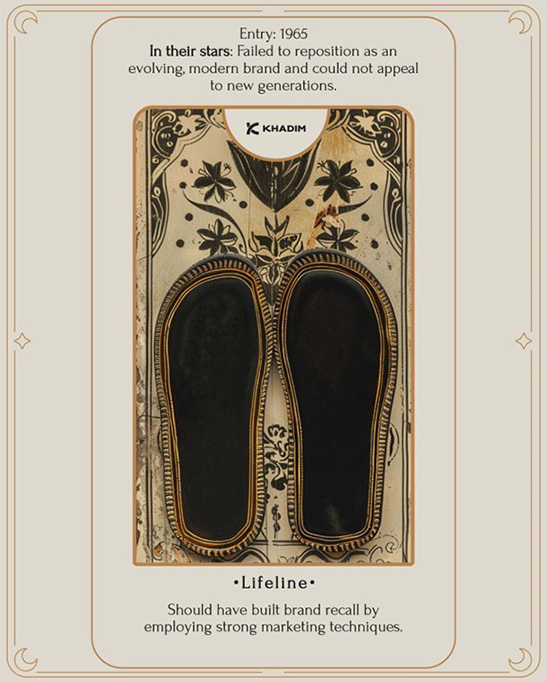
Once upon a time, Khadim’s footwear was a firm favourite all over India. Their premium yet affordable products were loved by customers in metro cities, while their pocket-friendly options were the choice of the hour in Tier II and III cities. However, with passing generations, they retired as a ‘timeless brand’ instead of one that could keep up with the ‘modern’ consumer, like their rising competitor Bata. Their products began to resonate more with Khadim’s being a national brand, than one that was consumer-centric.
Khadim’s Lifeline:
Khadim India’s story was less of a failure and more of a brand whose glory got lost in translation. Along with their constant attempts to upscale their mother brands and launch more subbrands, they needed to reposition themselves as an evolving brand, rather than one that is set in stone within its legacy. This could’ve been achieved through strong marketing techniques like making a fresh, renowned talent the face of the brand to build brand recall.
Tata Docomo
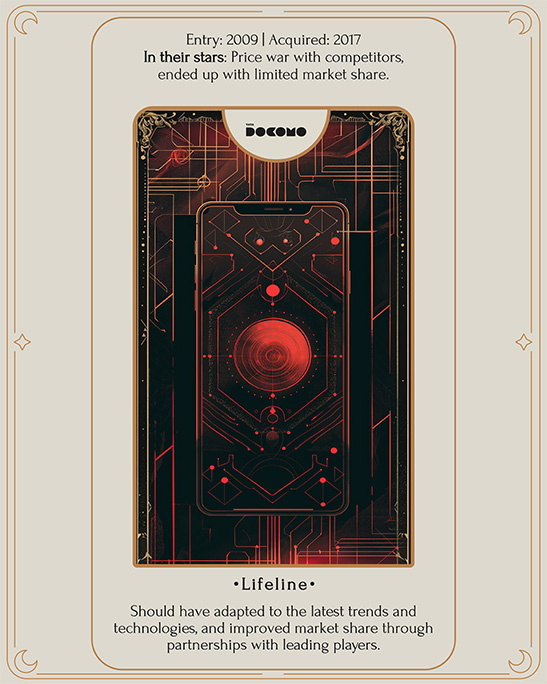
With Tata Docomo’s pay-per-use policy came the golden age of affordable telecom. In 2010, they became the first private sector telecom company to launch 3G services in India, clocking in about 49 million subscribers in the next seven years. By 2019, however, price competition from other big players meant that Tata Docomo had a limited market share. Their issues with partners Tata Group and NTT Docomo also affected their business.
Tata Docomo faced strong competition upon the entry of Airtel and Jio in the Indian mobile market, losing out to the price war. Ultimately, they were acquired by Bharti Airtel in 2017.
Tata Docomo’s Lifeline:
In a fast-expanding cellular market, Tata Docomo’s partnerships with leading telecom players could’ve been a boon over a bane. They could’ve improved their market share with the adoption of the latest, low-cost technologies, and relied on aggressive offers and target marketing to compete with leading players.
Moser Baer
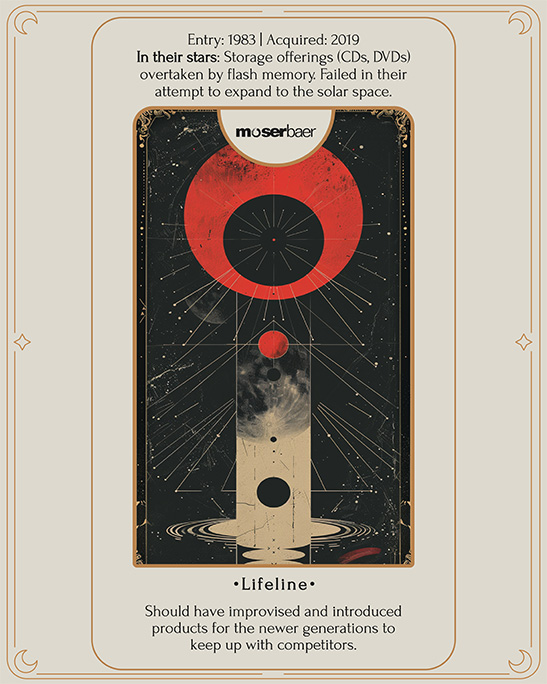
venture into the photovoltaic space because they were short on the resources to invest for profit and could not keep up with competition from Taiwanese countries. As they took baby steps in solar, they missed considering China’s vast manufacturing potential and had to accept defeat in this industry as well.
In 2019, Moser Baer’s accounts were deemed fraudulent by the Central Bank of India. Vinpower, Inc., spotted this void in the tangible digital storage market, and acquired the rights to Moser Baer, introducing a new line of digital storage products under the Moser Baer brand.
Moser Baer’s Lifeline:
Moser Baer went from a trusted legacy brand to one associated with fraudulence and duping. Thus, a rebranding exercise in collaboration with the right influencers and actors could’ve helped save them from vanishing from the market. Instead of venturing into uncharted territory and expanding to different industries, they should have retained their focus on digital storage and maintained the survival of their product lines, in a vintage fashion similar to Kodak.
Videocon
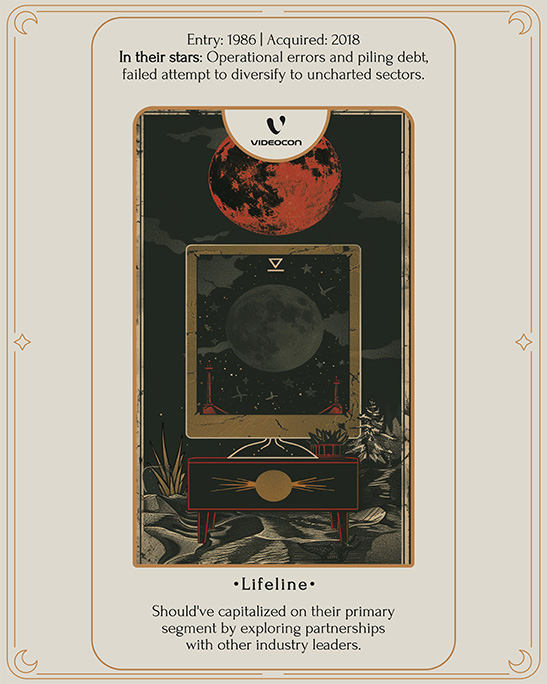
Videocon was once the pioneer of colour TVs. Now on the verge of liquidation, the brand’s downfall began with its decision to diversify the business into different sectors, by taking a lot of debt, and not using leverage efficiently. Their image was also badly hit after getting involved in various scams, particularly the ICICI Loan Scam. They had to file for bankruptcy in 2018, and Vedanta Group took over instead.
Videocon’s Lifeline:
Videocon’s life story is testimony to “Jack of all trades, master of none.” As a result of their FOMO, they shifted their focus from their primary segment, Consumer Electronics, and ended up trying to diversify without a plan. They should’ve capitalized on the trust they had managed to instill in their customers and continued to do what they did best. In this process, they could’ve also explored partnerships with other industry leaders to regain their place as a trusted brand for the country.
Fiat
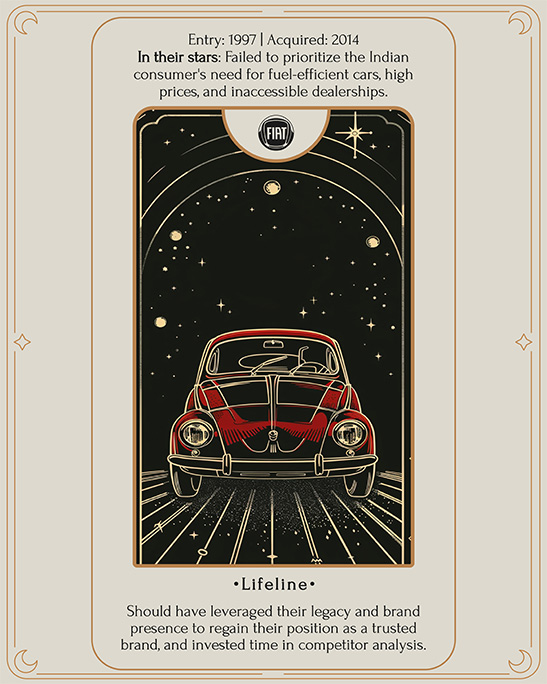
Fiat had premium cars for sale, but had to pack up its business from India due to many reasons: they neglected to prioritize fuel efficiency in their cars (a major concern for buyers searching for economical options), high prices, limited dealerships located in inaccessible areas, and poor service and spare part availability. Fiat stopped manufacturing cars at their leading plants across India until 2023, when The Stellantis Group evaluated bringing it back to the Indian automobile market.
Fiat’s Lifeline:
Fiat’s case study is a strong example of how brands fail to tap into their customer psychology. In Fiat’s moments of glory, the Indian consumer was attracted by fuel-efficient vehicles – offered by their competitors, Maruti Suzuki, Tata, and Hyundai. Cars like The Siena, Petra, and Palio should have been known for their high fuel efficiency over their build, quality, design, and performance. They had leverage in their brand visibility and presence since their designs were already loved worldwide, but failed to utilize it completely.
Meru Cabs
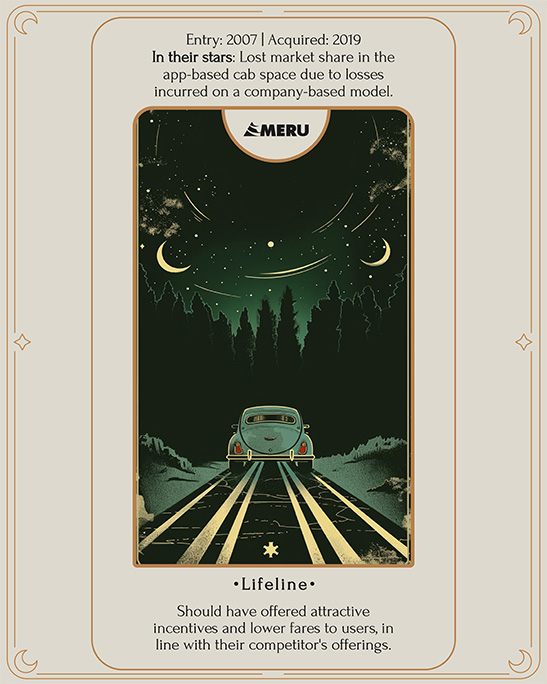
Upon the entry of Meru Cabs into the Indian market, business models were in flux. Most radio-taxi operators in India were navigating between the two major forms of operations: company-owned and franchise-based. Meru Cabs, running on the former, faced difficulties in breaking even financially by 2011 due to a series of reasons – internal inefficiencies, long cab downtime, lack of qualified drivers, driver strikes, rapidly expanding operations, and growing competition. In 2019, Mahindra & Mahindra acquired a 55% stake in Meru Cabs. Meru went from being a leader in the app-based cab space to a single-digit market share with the rise of Ola and Uber.
Meru’s Lifeline:
Meru Cabs moved towards a marketplace model to regain its position in the space, but could not thrive alongside the rapidly growing Uber and Ola Cabs who were offering attractive incentives for passengers. They failed to adapt to an evolving audience; while their initial decision to prioritize technology over advertising gave them a strong foundation, they should’ve given a second thought to the marketing strategies being used to reach newer generations of users.
Planet M
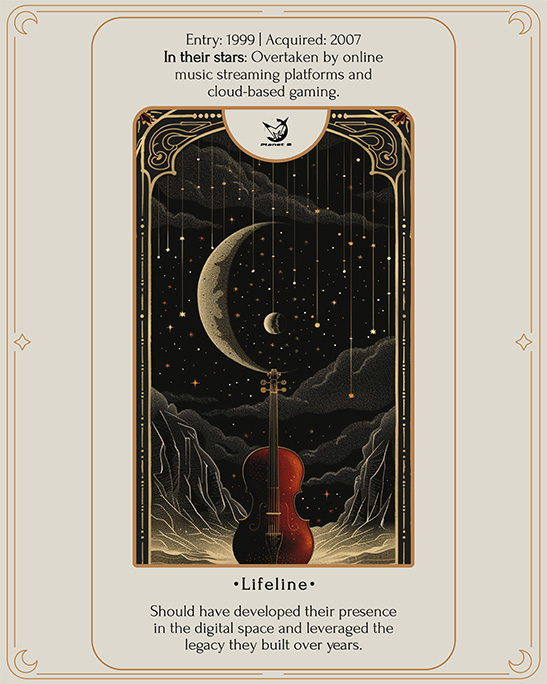
Out of all the brands on this list, Planet M is the one that could have truly not managed to escape its slow death: digital platforms entered the market at lightning speed and wiped out the intimate experience of finding the right CD at a music store. Planet M did everything right in its prime: built a loud persona that resonated with its young customers, offered in-store experiences like album launches and live performances, and created listening stations at every outlet for listeners to sample an album before purchasing it. The supermarket of music stores, however, died a tragic death when the internet made streaming and downloading music easier. To stay relevant, they began to sell mobile accessories, gaming consoles, MP3 players, iPods, etc. They also collaborated with smaller, local shops for movie rentals, but it was not enough to prevent them from shutting shop.
Planet M’s Lifeline:
The demise of Planet M also led to the exit of an intimate music listening experience for the upcoming generation. While the rise of digital music completely wiped out the brand from the music space, they should’ve attempted to adapt to this evolution and develop their presence in the digital space. As a trusted, legacy platform that has been a part of people’s families across generations, they could’ve continued to market their evergreen, loud brand image.
Barista Coffee
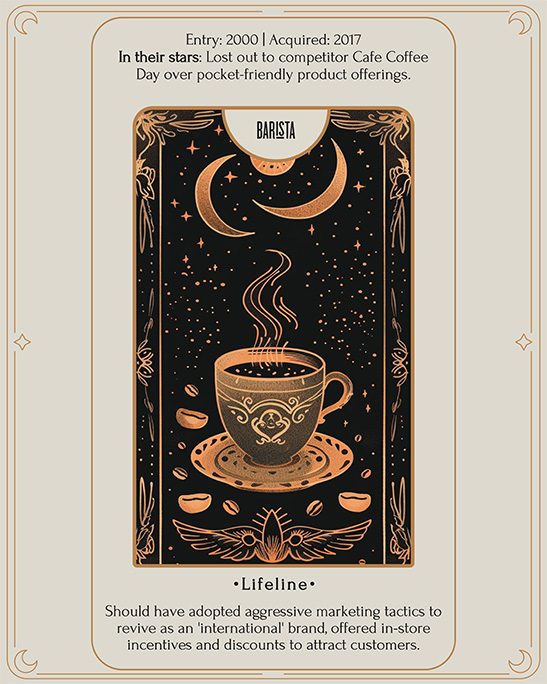
Before Starbucks entered the Indian market, Barista Coffee was known as the ‘Indian Starbucks.’ It pioneered the branded coffee culture in the country, thriving with a first-mover advantage over other competitors. Barista Coffee painted ‘grabbing a cup of coffee with a loved one’ as an inviting hangout proposition; particularly appealing to young consumers who prefer not to consume alcohol while socializing.
Things went south for the brand when its competitor, Cafe Coffee Day, emerged with a similar range of products but at much cheaper prices. Within only five years of being active in the market, Barista Coffee had seen four new CEOs and frequent changes in stakeholders. In 2017, the 130-odd outlet chain, sadly a loss-making business, was acquired by Carnation Hospitality.
Barista’s Lifeline:
To keep up with an evolving audience, Barista needs to uplift its brand image from ‘one of the olden days’ to a pocket-friendly, exciting coffee that keeps one going. To appeal to the masses, the brand needs to have an international appeal to shine amidst current leaders in the coffee market, such as Starbucks and Blue Tokai Coffee Roasters. Aggressive marketing strategies can push the brand in the right direction and reach the right target audience. Attractive discounts, in-store events, and curated events located at Barista chains can help invite customers back to the experience of having coffee with someone and spending time.
Prevent, Don’t Repent!
Building a brand is the first step in a long journey; its success is determined by whether the viewer finds it worth remembering. For this, they need to forecast and plan for changing needs and environments. They need to evolve with time and win people’s hearts with the story they tell to resonate with people across generations.
Along with this, keeping up with changing times and trends is of key importance: with the right technology and tools, and in sync with the latest trends, brands can help evolve with consumer preferences and improve their experiences over time. They must also stay updated on the strategies of their competitors; for a brand to continuously grow, it needs to be well aware of the competitor brands’ product offerings, pricing structure, marketing strategies, etc., and strive to keep enhancing its own. Better brand modification can be successfully achieved through constant and relatable communication with the consumer and proper feedback mechanisms in place.
Brands must remember that sustaining, providing, and evolving might make it easier to win a customer’s trust, but staying relevant wins over everything. So, put yourself in your consumer’s shoes, and then sell those shoes to them!
To change your brand game, connect with us – www.bochfernsh.com

